Planning for Backward Area, Desert, Drought-Prone, Hill Tribal Area Development, Island Territories | Geography Optional for UPSC PDF Download
Backward Area Planning
- Backwardness is relative, multi-dimensional, and is based on perception. It differs in time, space and nature. Also, it refers to spatial as well as structural disparity. Due to the complexity, there is no unanimously accepted definition.
- Despite the government’s investments in development projects, free play of market forces favors the polarization of economic growth at certain favorable locations which results in regional inequalities in development.
- The backwardness of a place and that of the people living there get impacted upon each other. This is so because the people and places are interwoven in symbiotic relationships.
- India is among the few developing nations, which have started comprehensive development programs for their backward areas. Indian planning for area backwardness, growth with justice is one of the main objectives of planning in India. It promises the promotion of socio-economic upliftment of backward people on one hand and the development of resource potentials of backward areas, on the other. Hence, it involves both social and spatial justice. India is a vast country with a variety of landforms and ethnic groups. The interplay of people with the land has brought out different patterns of developments.
- Interestingly in the Indian perception, backwardness is associated with rural areas, while in reality, all backward areas are rural but all rural areas are not backward. Similarly, the majority of the population in a backward area comprises of backward people but all backward people are not found only in backward areas. It implies that in spatial coverage backward areas and backward people are not synonymous.
Identifying Backward Areas
- There are two broad approaches of operationalizing the concept:
- Index-based,
- Problem area.
- The method of the Index-based approach rely on some overall index for ranking areas and treat all areas below some cut-off point as backward.
- The problem area-based approach identifies problem areas in different categories by specifying the constraints on development that can only be mitigated by special measures.
- Pande Committee (1969) emphasized broadly on the percentage of the population engaged in the industry while the Chakravarty Committee stressed on the percentage of the agricultural population, irrigated areas, net sown area and literacy for identifying the backward area. In India, both the approaches, Index-Based and Problem Area, have been adopted. The former was used for identifying industrially backward areas whereas the latter for drought-prone, desert, hill, etc.
- The areas identified as backward for the purpose of planning must have three characteristics:
- Potential for development
- Inhibiting factors preventing them from realizing their potential, and
- A need for special programmes to remove the bottlenecks.
- In the identification and demarcation of backward areas, the geographical unit needs to be defined. The quantitative data, for the units on the indicators chosen, must be available.
- During the 4th FYP, the Planning Commission appointed a study group, which studied a set of 15 parameters, and after statistically mapping these 15 parameters for the country, it identified 238 districts across India as backward.
Evolution Of Backward Area Planning in India
- Development of backward areas was always given emphasis even in the embryonic stage of Indian planning. The 1st FYP made allocations for the development of scarcity-prone areas.
- During the Second Plan, there was the establishment of large industrial complexes in mineral-rich backward areas resided in by the tribals in central India.
- The third plan (1961- 66) devoted a full chapter on balanced regional development.
- Fourth plan was the watershed period in the history of backward area planning in India. It initiated a two-pronged strategy viz. ‘target group’ and ‘target area’ programmes. The former was devised for the removal of social inequalities and the latter for tacking regional backwardness.
- The target groups identified during the fourth plan included small and marginal farmers, as well as agricultural labourers. Small Farmers Development Agency (SFDA) targeted the small farmers, households having landholdings of 2 hectares or less. Such households accounted for 52% of total rural households. Marginal Farmers and Agricultural Labourers Development Agency (MFAL) was formed to look after the interests of the marginal farmers and the agricultural labourers. The category of ‘target areas’ included the hill, border, drought-prone, and industrially backward areas. These programmes, conceived during the Fourth Plan (1969-74) were implemented mainly during the Fifth Plan (1974-79).
- In the sixth plan, no new programme of backward area development was started. In the 7th plan, Border Area Development Programme was started. After the 7th plan, no new programme related to of backward area has been initiated.
Chronology of Plans In India
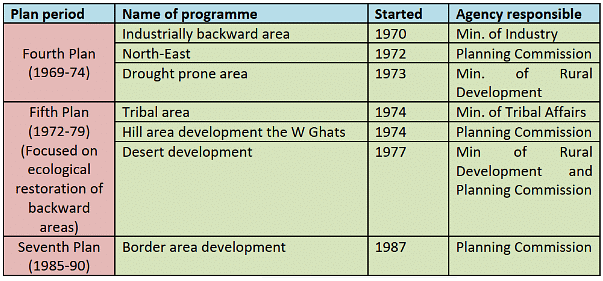
Measures For Development of Backward Areas
- All parts of a country are not equally endowed with rich natural and human resources. Resource-rich areas leave behind their poor counterparts on the path of development. Gradually the gap widens and as a result disadvantaged places and people conscious of the widening gap, demand measures to mitigate disparity.
- Various governments gave numerous fiscal and other incentives for the development of agriculture, industries, transport, and social amenities in these areas such as:
- Grants for minor irrigation projects, cottage, and small industries; emphasis on roads and electricity development.
- Grant of higher development rebates to industries located in backward areas.
- Grant of exemption from income tax, including corporate tax for 5 years after providing the development rebate.
- Exemption from payment of import duties on plant and machinery, components, etc. imported by units set up in backward areas.
- Exemption from excise duties for a period of 5 years.
- Exemption from sales tax, both on raw materials and finished products to units set up in specified backward areas for a period of 5 years.
- Transport subsidy
- Industrial estates like Okhla (Delhi), Naini (Allahabad), Rajkot (Gujarat), Guindy and Vieudhunagar (TN), Kanpur, and Agra (UP), Palghat, Trivandrum etc. were established to encourage the growth of small scale industries.
Main Highlights
- The concern for regional inequalities in development is a universal phenomenon. The theory and practice of backward area development is the outcome of this concern.
- India is one of the few developing nations to start development programmes for its backward areas. Since its inception, development planning in India has shown its concern for regional inequalities, yet the fourth plan is a landmark in this direction.
- A large majority of Area Development Programmes in India were identified during the 3rd and 4th plans and they become operative during the 5th plan. No such programme came into operation after the 7th plan.
- HADP was the first and Border Area Development was the last in the order of identification of areas of such programmes. Industrially Backward Area Development was the first to come into operation.
- The responsibility of implementing the area development programmes in India was with the Planning Commission. But after creation of NITI Ayog, their implementation lies on the part of NITI Ayog and respective ministries. Programmes for tribal and industrial development are under the administrative controls of the respective central ministries.
- The development programme differs widely in terms of their coverage, time duration, and pattern of financial assistance.
- In a large and diversified country like India, fundamental/physiographic backwardness is the most widespread. Hence, the majority of area development programmes have been launched for the restoration of ecological balances in areas such as drought-prone, desert, and hill areas. Economic backwardness is no less widespread, whereas social backwardness is confined to tribal pockets.
- The areal coverage of area development programmes differ widely. The largest areal coverage programme (industrial backwardness) was 17 times larger than the smallest one (border area). The former covers nearly 70% of the total area of the country, while the letter covers only 5%.
- Majority of area development programmes are in operation for more than 2 decades. The DPAP has completed a maximum of more than 37 years while the border area programme is only 23 years old.
- The area development programmes differ widely in terms of financial assistance. While there are 3 types of financial arrangements, the majority of programmes are centrally assisted. The border and the desert are fully financed by the centre, while the DPAP is shared amongst the centre and states on a 50-50 basis and on 90-10 basis in Special Category States.
Hill Area Development
- Hill area constitutes 18% of the total area of the country where 70 million of the total population dwells.
- Hilly areas are characterized by poor accessibility and difficult terrain. Soils on the slopes are thin less productive and prone to soil erosion.
- The overall milieu comprising of topography, climate, culture and economy is different from plains, thus a different planning approach is required for hilly areas.
- Most of the hill areas are tribal areas. They are also getting the benefit of Tribal Area Sub-Plan.
- Apart from the above, all the rural development schemes are also being implemented in these areas.
- The development of mountainous regions depends upon the development of transport, network, land development, afforestation, and energy. These four things need high expenditure.
- Planning should be directed towards building physical infrastructure. The planning efforts should also emphasize on environmental consideration and ensure that the externalities of development do not take a toll on the natural and cultural setting of the hill areas. E.g. ideally, 60% of the geographical area of mountainous states should be forested.
Hill Area Development Program
- Hill Area Development Program was launched during the Fifth Five Year Plan (area based planning). DDP, CADP, TADP were also launched during the plan. The basis was modified Gadgil formula for central assistance to states.
- Hill Area Development Program focuses on people’s participation especially women with following objectives:
- Eco-restoration
- Eco-development
- Eco-preservation
- Hill Area Development Program also focused on socio-economic development of tribal communities along with conservation of soil and water resources. Development of land use plan for forest as well as cultivated areas was also focused upon.
- As per Gadgil formula, special central assistance needs to be given to certain areas which need more financial support due to their backward situation.
- The financial assistance will constitute 90% assistance by Central government and 10% by State Government.
- On the basis of requirements under Gadgil formula following areas have been identified:
- Sikkim, Arunachal Pradesh, Nagaland, Manipur, Mizoram, Meghalaya, Tripura, Jammu and Kashmir, Himanchal Pradesh, Uttarakhand.
- Certain hill areas of Assam and Tamil Nadu.
- Some takulas of Maharashtra, Karnataka, Kerala, Tamil Nadu and Goa.
- The above areas account for 22% of total geographical area of India where only 10% of Indian population dwells.
- North Eastern India is more focused under Hill Area Development Program, since 7th plan special allocation is made in the name of North Eastern Council.
- On the field, the Hill Area Development Program objectives are being pursued in the form of several sub-plans and the allocations have drastically increased from 5th plan i.e. 540 crores to 5400 crores in 9th plan.
- In order to strengthen physical infrastructure Ministry of Surface Transport, Railways have undertaken various projects to expand and improve roadways, railways, and waterways in the hilly regions. E.g. SARDP- North East, construction of 44000 km road and development of high altitude all-weather roads of the length of 9000 in North East by Border Road Organisation, railways of Kathgodam is to be extended till Nainital, an extension of Kumarghat Terminus to Agartala and Jijibam Terminus to Imphal, railway projects in Kashmir.
- There is a comprehensive road map for the development of infrastructure in Northeast under the plan document of Vision 2020 North East.
- Hill Area Development Program falls into two categories:
- Those which are coexisting with boundaries of state or UTs. E.g. North Eastern region, Jammu and Kashmir, Himachal Pradesh, Special Category State whose outlay is met substantially out of central assistance.
- Those areas which form the part of the state such as Assam, Uttarakhand, West Bengal. Although the responsibility for the development of these areas lies on the part of the State Government but the Central assistance is also required
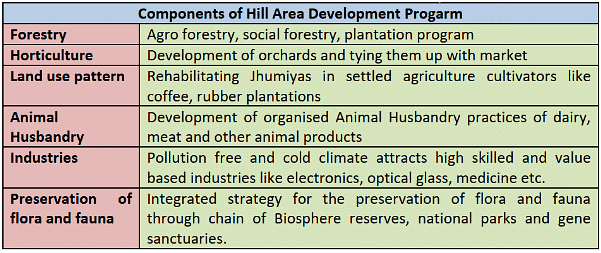 Hill Area Development Program
Hill Area Development Program
Problems In Hill Area Development Plan
- Social structure of the region:
- The tribal dwellers of hilly and forested areas do not cooperate with the administration in development activities due to their isolation from mainstream society.
- The militant outfits in Jammu and Kashmir and tribal areas have taken the advantage of the simplicity of the tribes and incite their feeling against the establishment, which results in violence, making foreign investors reluctant to invest in these areas. E.g. Dulhasti project in Jammu and Kashmir has been abandoned due to militant threats. The same problems are being faced by Kashmir railways.
- Improper utilization of allocated funds:
- Per head allocation of the Central assistance to North East, India is Rs 5200, but due to lack of proper management, there has been lopsided utilization of and even non-utilization of funds. E.g. Nagaland and Arunachal Pradesh have utilized only 60% of their allocated fund under HADP.
- Internal rivalry among tribal groups especially in Northeastern India like Nagas Bodos etc are hampering the growth and development of the area.
- There is increasing hostility between tribes and non-tribes have been a major bone of contention in development activities in these areas.
- Special allocation of funds is required for the handling of the extreme events of natural hazards which cannot be handled by regular funds.
- The people from tribal and hilly areas are not very enthusiastic about developmental activities due to unawareness, poverty, and scattered settlements. Thus, the development process is slow and skewed. Urban areas are usually more benefitted.
Way Forward
- Politico-admin commitment is the need of hour. There should be focus on people’s participation and comprehensive development scheme must be chalked out for the development of hilly areas.
- Apart from the above upgradation of the skills of women at Krishi and Van-Vigyan Kendras, social fencing like voluntary and self imposed discipline in managing society’s resources at local level is required.
Drought Prone Area Development
- It is the earliest area development program launched by the Central Government in 1973-74 to tackle the special problems faced by those fragile areas, which are constantly affected by severe drought conditions.
- These areas are characterized by large human and cattle populations which are continuously putting heavy pressure on the already fragile natural resource base for food, fodder, and fuel.
- The major problem in drought-prone areas are the continuous depletion of vegetation cover, increase in soil erosion, and fall in groundwater levels due to continuous exploitation without any effort to recharge underground aquifers.
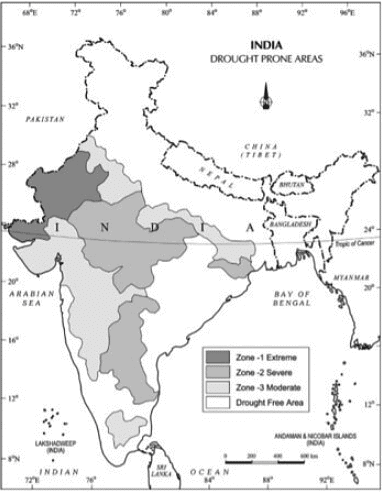 Drought Prone Areas
Drought Prone Areas
Objectives
- The basic objective of the Drought Prone Area Development program is to minimize the adverse effect of drought on the production of crops and livestock and productivity of land, water, and human resources thereby ultimately leading to the “drought-proofing” of the affected areas.
- The tools through which the objectives for the development of Drought Prone Areas can be achieved are summarised below:
- Dryland farming
- Proper management of water resources through traditional methods
- Soil conservation through stubble mulching
- Afforestation by social and agroforestry.
- Development of livestock, pasture, and fodder.
- Drought Prone Area Development program covers 972 blocks, in 182 districts, in 16 states.
- The objectives are being met through development projects undertaken through watershed approach for land development, water resource development, and afforestation/pasture development. These projects constitute the major component of this program.
- Funding: Until March 1999 the funding contribution of Centre and State was in the ratio of 50:50, but after that funding contribution changed to 75:25 from Centre and State respectively.
Outcomes Of Drought Prone Area Development Program
- Though the program has a positive impact in terms of creating durable public assets, its overall impact in affectively containing the adverse effects of the drought was found to be not very encouraging.
- High-level technical committee set up under Prof. Hanumantha Rao in 1993, to review all development programs.
- Based on the recommendation of this committee, the watershed development approach was adopted which consisted of the participation of local people.
Major Components Of Drought Prone Area Development Program
- Soil and water conservation along with land development.
- Water resource development
- Afforestation and pasture development
- Further, there has been the addition of the following components in DADP:
- Technological innovations and technological adaptations such as contour budding furrow budding and mulching etc.
- Simultaneous cropping of fodder and pasture.
- Agroforestry and horticulture, dairy farming, sheep husbandry, etc.
- Some other important elements of DADP are as follows:
- Restructuring of cropping pattern and changes in agriculture practices.
- Development of subsidiary occupation.
- Each state has evolved its own organization setup for DADP, for e.g.
- Maharashtra is implementing DADP through District Planning Board
- Karnataka is implementing DADP through an Authority with Divisional Commissioner as Chairman
- Tamil Nadu implementing DADP through the District Development Corporation for one of the two districts under this program.
Problems of Drought Prone Area Development Program
- The implementation of DADP has been sectoral and spatially dispersed.
- The allocation of funds has been inadequate for DADP, apart from that there has been lopsided implementation and utilization of available funds.
- The participation of people has been lukewarm, which is the major hurdle in the proper implementation of DADP.
Tribal Area Development
- According to census of India 2001, the total population of the scheduled tribes was 8.3 million or 8.2 per cent of the total population of India. The government of India has included 427 communities in the scheduled tribes, given in the eighth schedule of the constitution of India.
- According to census of India 2011:
- 10.42 crore Indians are notified as ‘Scheduled Tribes’ (ST), of which 1.04 crores live in urban areas.
- STs constitute 8.6 per cent of the country’s total population and 11.3 per cent of the total rural population.
- The sex ratio among Scheduled Tribes is 990 females per 1,000 males, a significant increase from 978 in the 2001 Census.
- Madhya Pradesh has the highest Scheduled Tribe population (14.7 per cent).
- These are the first people who are living in areas of isolation and have been exploited throughout history. Their sense of history is shallow, in the sense that, after few generations, the remembered history tends to shade off into mythology. Their cultural ethos (language, religion, faith, traditions, and customs) are different from the other sections of society.
- Numerically, the most important tribes of India are Gonds (8 million), the Bhils and the Santhals, each having a population of more than 35 lakhs.
- Next to them are the Minas, the Mundas, and the Oraons; each having a population of more than 10 lakhs.
- Then comes the Hos, the Khonds, and the Kols; each having a population of more than five lakhs. Then there are 45 tribes, each having a population of between one and five lakhs. The smallest tribal community is the Jarawa and Sentales of the Andaman and Nicobar Islands.
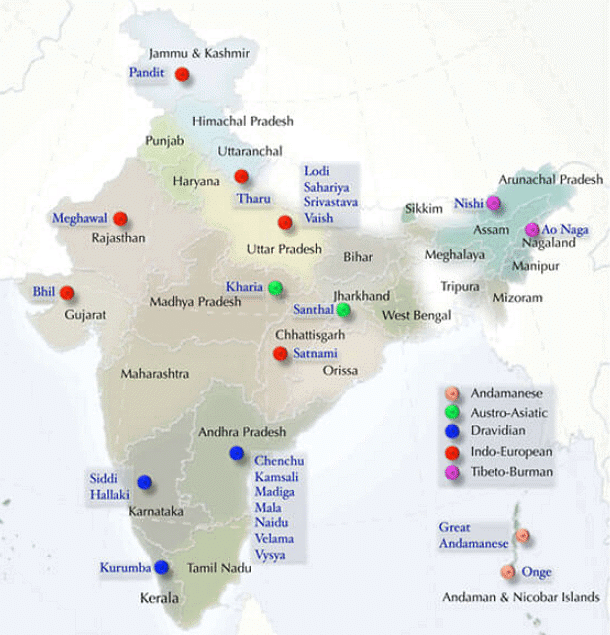 Major Tribes of India
Major Tribes of India
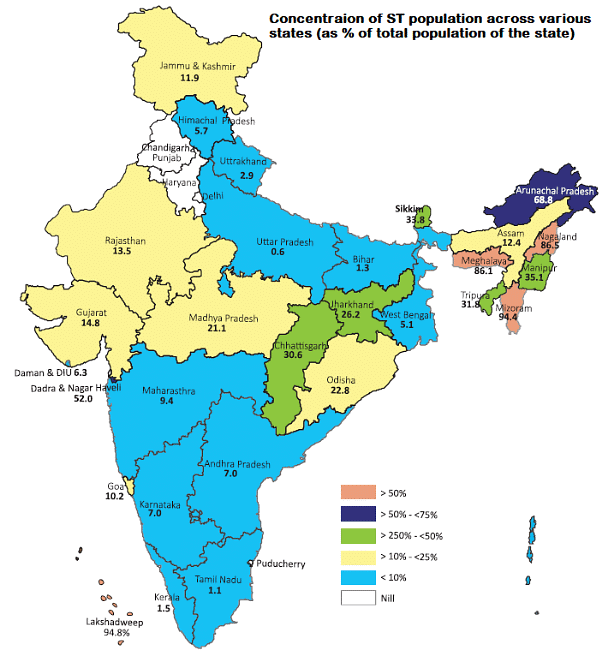 Concentration of SC/ST Population
Concentration of SC/ST Population
Defining Schedule Tribes & various committees
Schedule tribes were originally referred to as "backward tribes" in the 1931 Census, living in "Excluded" and "Partially Excluded" areas.
- The Government of India Act of 1935 called for representation of "backward tribes" in provincial assemblies for the first time.
- The Constitution does not provide a specific definition for Scheduled Tribes, but Article 366(25) outlines the process for defining them under Article 342.
- The Kaka Kalelkar Commission in 1953 defined Scheduled Tribes as groups that lead a separate and exclusive existence and are not fully assimilated into the larger community.
- The Elwin Committee in 1959 examined the functioning of Multi-Purpose Development Blocks for tribal development programs.
- The U.N. Dhebar Commission in 1960 addressed the overall situation of tribal groups, including land alienation issues.
- The Lokur Committee in 1965 recommended five criteria for identifying Schedule Tribes, including primitive traits, distinct culture, geographical isolation, shyness of contact with the larger community, and backwardness.
- The Shilu Ao Committee in 1966 addressed tribal development and welfare.
- The Tribal Sub-Plan approach emerged from committees constituted during the 1970s.
- The Bhuria Committee in 1991 recommended the enactment of the PESA Act of 1996.
- The Bhuria Commission in 2002-2004 focused on a wide range of issues from the Fifth Schedule to tribal land and forests, health and education, the working of Panchayats, and the status of tribal women.
- The Bandopadhyay Committee in 2006 looked at development and governance in Left-Wing Extremist areas.
- The Mungekar Committee in 2005 examined issues of administration and governance.
- The committees dealt with two main issues, development and protection, but the outcomes for tribal communities have been mixed.
Economy
- The scheduled tribes are essentially subsistence cultivators. Over 90% of them (Gonds, Bhils, Santhals, Mundas, Oraons, Nagas, Khasi, Mizo, etc.) are dependent on cultivation of crops.
- The tribes of Andaman and Nicobar are dependent on food-gathering and hunting.
- Most of the forest dwellers (Birhore, Mallar, Kharia, Kadar, Chenchu, etc.) gather various roots and tubers, fruits, honey, manufacture ropes from wild creepers, and keep their collection for personal use or exchange it with agricultural produce. They occasionally indulge in fishing and hunting. The Todas, inhabiting the Nilgiris are pastoral tribes.
Programmes for the Development of Scheduled Tribes
- The scheduled tribes, as stated above are living in areas of isolation. Their habitat and cultural milieu are quite different from each other, and therefore, their development needs and problems are different from each other.
- A number of programmes have been initiated by the central and state governments for the development for the development and welfare of the scheduled tribes. They can be classified as under:
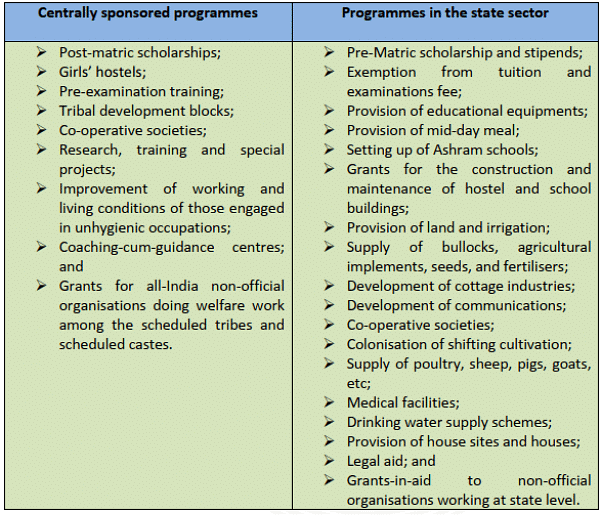
Areas of Development
- Education: The literacy rate of the scheduled tribes is only 49.5% as against the national average of 73.0% (2011). Since education plays an important role in bridging the gap between the tribals and non-tribals and in helping the process of change and modernisation, a considerable amount of money is being spent on the provision of educational facilities to the tribes. For this purpose, award of scholarships, hostel facilities, stipends, stationery grants, boarding grants, mid-day meals etc. have been provided by the central and state governments. The coaching and guidance facilities are also provided to tribal students who appear for the Indian administrative services (IAS) and other competitions. There are overseas scholarships for them. Schemes are also being operated to train tribals to work as teachers in their own areas.
- Employment: The central and state governments have reserved 7.5% of the vacancies for the candidates of scheduled tribes. Reservation in direct recruitment to class III and class IV posts which normally attract candidates from a locality or region are fixed in proportion to the population of the scheduled tribe in the respective state and Union Territories.
- Agriculture: About 90% of tribals are cultivators and about 82% of them are engaged in primary economic activities. Most of them are dependent on shifting and/or rudimentary cultivation. The size of holding and the yield per unit area in tribal areas is generally very low. The central and state governments are assisting them in the procurement of improved seeds, fertilisers, irrigation, credit facilities, soil conservation and land reclamation, adoption of better implements.
- Co-operatives: To achieve the transformation of tribal agriculture and to prevent the exploitation of tribals from moneylenders, forest contractors, and other non-tribals, it is necessary to develop ‘co-operation’ and ‘co-operatives’. Because of extreme poverty, most of the tribals have to borrow money from the moneylenders and traders. However, once they incur a debt, they land into the clutches of the moneylenders from which they find it difficult to extricate themselves. They also need protection from forest contractors also who engaged them as bonded labourers at very low wages. Here, the co-operatives can play a vital role.
- Communications: Most of the tribals are living in hilly and mountainous areas or in areas of isolation or relative isolation. It is necessary to provide roads, transport, and other means of communication if they are to be absorbed and assimilated in the national stream. They also need marketing facilities to dispose off their surplus product.
- Land distribution and land alienation: The problem of land alienation is a serious one in tribal areas. Moneylenders, sahukars, and other non-tribal people have continued to grab the land belonging to the tribals on one pretext or the other. To cope with this problem. Safeguards along the following lines have been provided:
- Provisions restricting the transfer of tribal land to non-tribals by sale, as found in Gujarat, Odisha, and Rajasthan.
- Provisions restricting transfer of tribal land to any person – tribal or non-tribal, as found in West Bengal, and
- Provisions restricting the transfer of tribal land by any means.
- Despite all these legal safeguards, it has not been possible to check land alienation.
- Industrialisation: The state governments carried out programmes for developing cottage industries and subsidiary occupations among tribal people. These include bee-keeping, poultry, sheep rearing, weaving, sericulture, and palm-gurs. In addition to these, some important industrial projects were located in tribal areas. These included Bhilai, Bokaro, Burnpur, Durgapur, Raurkela, Bhadravati, Kalinga, etc. these projects have provided considerable employment opportunities to tribal people as unskilled labour.
- Tribal development agency projects: The tribal development agency projects were established in some areas on an experimental basis in 1971-72. In the selected districts the work of the tribal development agencies is being implemented under the chairmanship of the district collector. The agency also has a full-time project officer and other district officers as members.
- Other schemes of development: A number of schemes were also undertaken to improve the housing, drinking water, and sanitary conditions of tribals and in providing adequate medical facilities to them
Criticism
The benefits, however, have failed to reach the lower strata of the society and got concentrated the hands of the upper crust of the tribal community.
The most important criticism of the tribal in development blocks is that the whole programme has been carried out without the participation of tribal people. The tribals had no particularly say in the programmes formulated for their own development, nor were their co-operation obtained in the implementation of these programmes. The unchanging bureaucracy has failed to fulfil the role of development agency.
The role of local politicians and local elite power was also not in the interest of the tribal masses. They perpetuated the situation in their self interest.
Regional Planning and Development of Island Territories
- India has more than 1000 islands in the Bay of Bengal and the Arabian Sea.
- Out of the 247 inhabited Islands, 204 lie in the Bay of Bengal and 43 in the Arabian Sea. Being surrounded by water on all sides, these islands territories have unique ecosystem.
- The islands are occupied by the tribal ethnic groups, having their unique primitive cultures. Islands and their beaches are attracting a large number of tourists. The islands therefore, need special strategy for their socio-economic sustainable development.
The Union Territory of Andaman and Nicobar
- The population of Andaman and Nicobar island according to census 2011 is 380,581
- There are 556 islands in the union territory of Andaman and Nicobar. Out of these 36 are permanently inhabited.
- Most islands are in the Andaman group, 26 of which are inhabited. The Nicobar Islands comprises 22 main islands (10 inhabited). The Andaman and Nicobar islands are separated by the ten degree Channel, about 150 km wide.
- The total area of Andaman Islands is about 6408 sq km, and that of Nicobar Islands approximately 1841 sq km.
- The Andaman and Nicobar islands are endowed with Tropical Rainforest. These forests consist of a mixed flora with elements from Indian, Malaysian, and Myanmarese floral strains.
- So far, about 2200 varieties of plants have been recorded, out of which 200 are endemic and 1300 do not occur in the mainland of India. Andaman forest is rich in timbers species like Gurjan and Padauk.
- About 50 varieties of mammals, 270 varieties of birds, and 225 species of butterflies are found in Andaman and Nicobar. Mount Harriet National park is one of the richest areas of butterfly and moth diversity on these islands.
- The indigenous people of Andaman are:
- The Jarawa,
- The Jangil (or Rutland Jarawa)
- The Onge, and
- The Sentinelese (most isolated of all groups).
- The indigenous people of Nicobar are:
- The Nicobarese, and
- The Shompen
- The indigenous people of Nicobar are restricted to the interior of Great Nicobar.
- A total of 48,700 hectares of land is used for agricultural purposes. Paddy, the main food crop, is mostly cultivated in Andaman group of islands. Coconut and Areca nut are the cash crops. Pulses, oilseeds, and vegetables are also grown.
- There are 1375 small-scale, village, and handicraft units. Two units are export oriented in the line of fish processing activity.
- Moreover, there are shell and wood based handicraft units. There are four mediumsized industrial units.
- The Small Scale Industrial units are engaged in the production of polythene bags, PVC conduit pipes and fittings, paints and varnished, fibre glass and mini flour mills, and soft drinks and beverages. Small-scale and handicraft units are also engaged in shell crafts, bakery products, rice milling, and furniture making.
- The Andaman and Nicobar islands integrated development corporation is actively busy in the promotion of tourism, fisheries, and industrial financing and functions as the authorised agency for Alliance Air/Jet Airways.
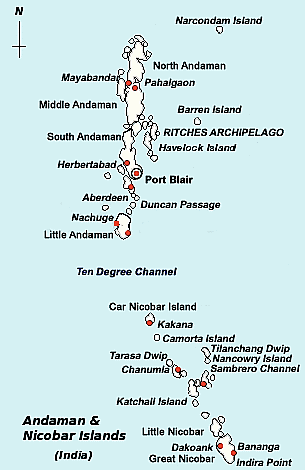 Andaman & Nicobar Islands
Andaman & Nicobar Islands
Lakshadweep
- Lakshadweep Consists of 12 atolls, 3 reefs, and 5 submerged banks, with a total of 43 islands, the Lakshadweep is located about 200 to 300 km off the coast of Kerala in the Arabian Sea.
- The total land area of the territory is 32 sq km.; eleven of the islands are inhabited. The main islands are:
- Agatti
- Pitti
- Androth
- Kavaratti
- Kalpeni
- Investigator bank, and
- Minicoy Island.
- Kavaratti is the capital of Lakshadweep.
- The total population of the territory was 64,473 according to 2011 census. The islanders are ethnically similar to coastal Kerala’s Malayalam people, and were influenced by the Arab traders.
- Inhabitants of Minicoy, the Southernmost and largest island, closely resemble Maldivians. Most of the indigenous population (about 99%) is Muslim. The locals call themselves the Div-I or Aminidivi (from the mother island). The people are largely dependent on fisheries, as soils on these coral islands are poor.
- The coral ecosystems of the islands and the scenic appeal of Lakshadweep are attracting the domestic and international tourists in a big way.
- Since such a small region cannot support industries, the government is actively promoting tourism, aquaculture and fisheries. Tourism is one of the important economic activities in these islands. These islands have been recognised as an important ecotourism place of India as a source of income.
- The Agatti Aerodrome on Agatti Island is currently the only airport in the Lakshadweep. Also, from April 2007, a private carrier, kingfisher airlines, has commenced flights to and from Agatti. Kingfisher connects Kochi and Bangalore to Agatti. The other islands are connected by a helicopter and boat service.
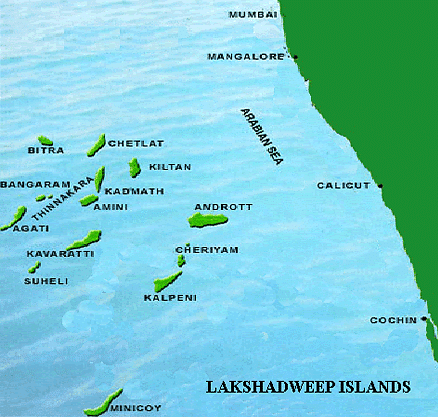 Lakshadweep Islands
Lakshadweep Islands
Sagar Island
- Sagar Island, also known as Gangasagar, lies on the continental shelf of Bay of Bengal, about 150 km south of Kolkata. The island stretches over 300 sq km and has 43 villages with a population of over 160,000.
- The island is the home to the endangered royal Bengal tiger. It is also rich in mangrove swamps, waterways, and small rivers. This land is a famous Hindu pilgrim place.
- Every year on the day of Makar Sankranti (mid of January), millions of Hindus gather to take a holy dip in the confluence of Ganga and offer puja in Kapil Muni temple. The Kolkata port trust has a pilot station and a lighthouse on this island.
- The government of West Bengal is planning to connect Sagar Island with the mainland with a 3.3 km bridge costing around INR 6,000 million.
- In addition to these, there are a number of islands around Kathiawad, Mumbai, Kochi, Tuticorin, and along the coasts of Tamil Nadu, Andhra Pradesh, Odisha, and West Bengal.
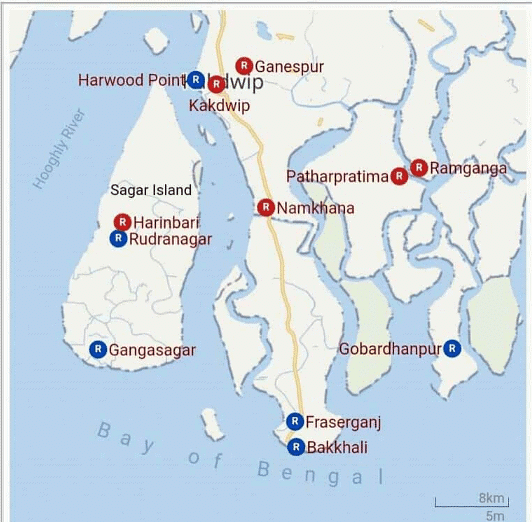 Sagar Island
Sagar Island
Strategy For Development of Island Territories
- The basic problem of the indigenous people living in the islands of Andaman Nicobar, Lakshadweep, etc., is that of poverty, low standard of living, hunger, starvation, malnutrition, facilities. Moreover, they have been subjected to exploitation for centuries by the non-tribal people.
- Keeping all these considerations in view, the government of India has initiated special schemes for the development of Indian island territories. Some of the steps which may go a long way in improving the income, health, education, and quality of life of the inhabitants of the islands territories are as under:
- The economy of most of islanders, especially that of the Andaman and Nicobar Island is forest based. In order to enhance the resilient characteristics of the evergreen and deciduous forests, there is a need to bring more areas under national parks and biosphere reserves.
- Many of the island territories are made of coral formations; special efforts are to be made is conserve the corals ecosystem.
- In the hot and humid climate of the Islands, the role of soil erosion is significantly high; Afforestation in the degraded lands can help to overcome this problem.
- Forest based cottage industries and handicraft can provide employment at the village level. Processing of areca nut, coconut products, and fisheries and coirmaking industries can generate appreciable employment and income to the people.
- The lush green forests, isolation, aesthetic beauty, and scenic appeal of the island are great tourist attractions. Thus, there is a great potential for the development of eco-tourism.
- There is enough potential for the development of fisheries in the coastal creeks, atolls, and bays for which special strategies need to be adopted.
|
304 videos|718 docs|259 tests
|





















